
Lawn Care 101 – Raking
Our first video of this segment is super straightforward, but some get it wrong. Check out this quick video to ensure you’re not causing more harm than good to your lawn and its root system when raking.

Our first video of this segment is super straightforward, but some get it wrong. Check out this quick video to ensure you’re not causing more harm than good to your lawn and its root system when raking.
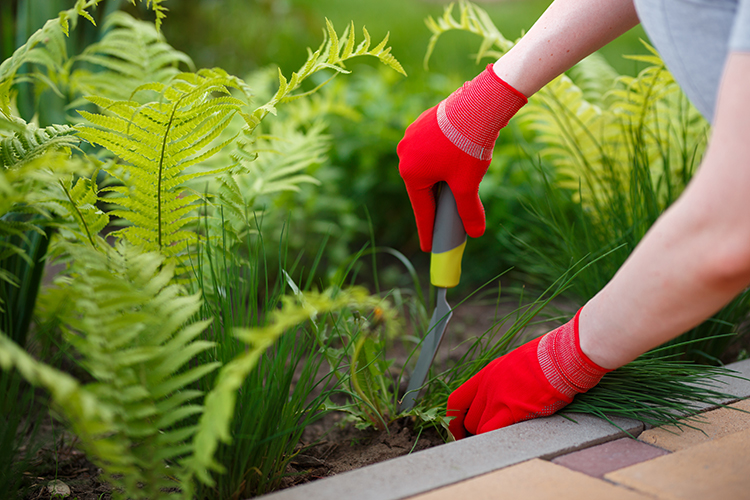
There are several classifications and definitions of weeds. However, in the very simplest terms, a weed is an unwanted plant in your lawn or garden.
No plant that’s perceived as a weed today has always been a weed. Once upon a time, they lived in a benign location and had no notable negative impact on their surroundings.
The turning point – when a plant becomes a weed – is when it invades a space where it is not desired and/or has an undesirable impact on people, animals, or other vegetation.
So, if they weren’t there to start with, how did those weeds get into your yard? They were carried there – transported by vehicle, animal, or on the wind.
And many seeds don’t need a whole lot of TLC to germinate. As long as they have oxygen and water, and a bit of sunlight, they will grow. So, the big question:
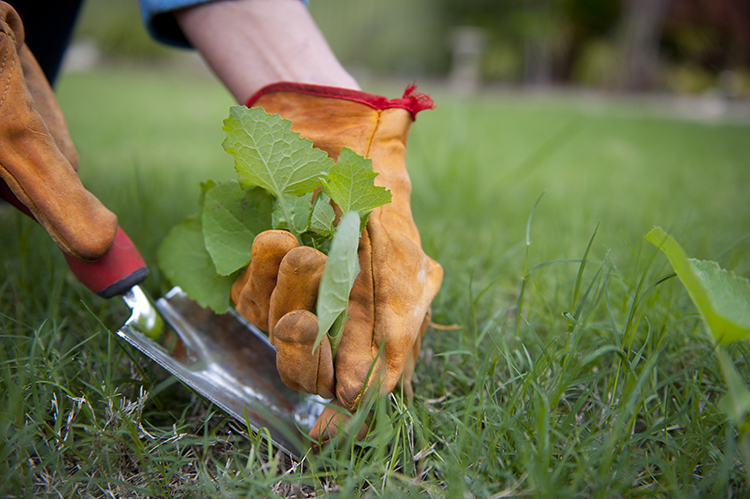
Let’s face it – weed avoidance is not a thing. However, there are strategies that will help you tame the beast and minimize the negative impact of weeds.
Weeds in your lawn and garden are the bane of any homeowner’s existence. But, armed with the information above, you’ll have a better understanding of where they’re coming from and how to control them.
Ready, set, weed!
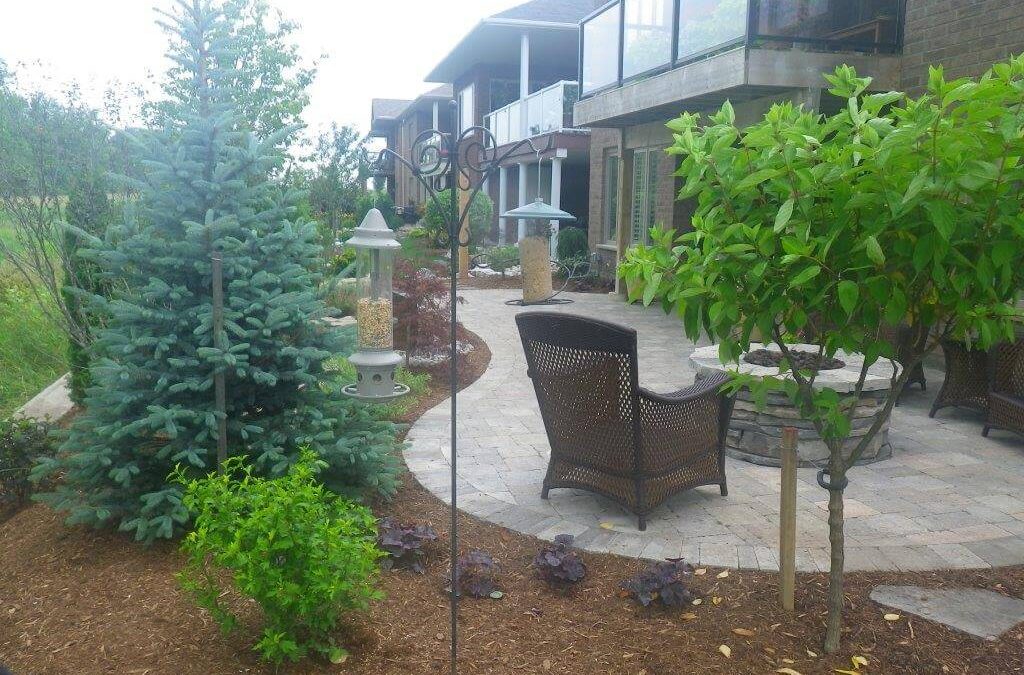
When we’re consulting with clients about their goals for new landscaping projects, by far the most requested characteristic is “low-maintenance”. But keep in mind that “low-maintenance” doesn’t mean “no maintenance”, so there’s still some work involved in keeping your lawn and garden looking great all season long.
If you’re looking to minimize the amount of work your lawn and flowerbeds need, we’ve got some tips that will allow you to spend more time enjoying your outdoor living spaces and less time maintaining them.
The Low-Maintenance Lawn
It may surprise you to learn that your lawn generally requires a lot more time to maintain that gardens do. Weeding, feeding, seeding, sodding, cutting, trimming, and watering all repeatedly require time, effort, and resources.
As such, the first thing we recommend doing is considering how much lawn you need for your lifestyle. While grass-covered turf does offer certain environmental benefits like absorbing toxins and carbon dioxide, other landscaping options can be just as beneficial. Chances are you can drastically reduce the amount of grass in your yard and replace those areas with other, much lower-maintenance elements.
One sure-fire way to reduce high-maintenance grass is to add some hardscaping to your yard. In addition to your driveway, porch, and deck, you might consider expanding your living space with a stone patio, fire pit area, and/or walkways. Adding crushed stone and pavers to high-traffic areas can significantly reduce maintenance while improving draining and weed control.
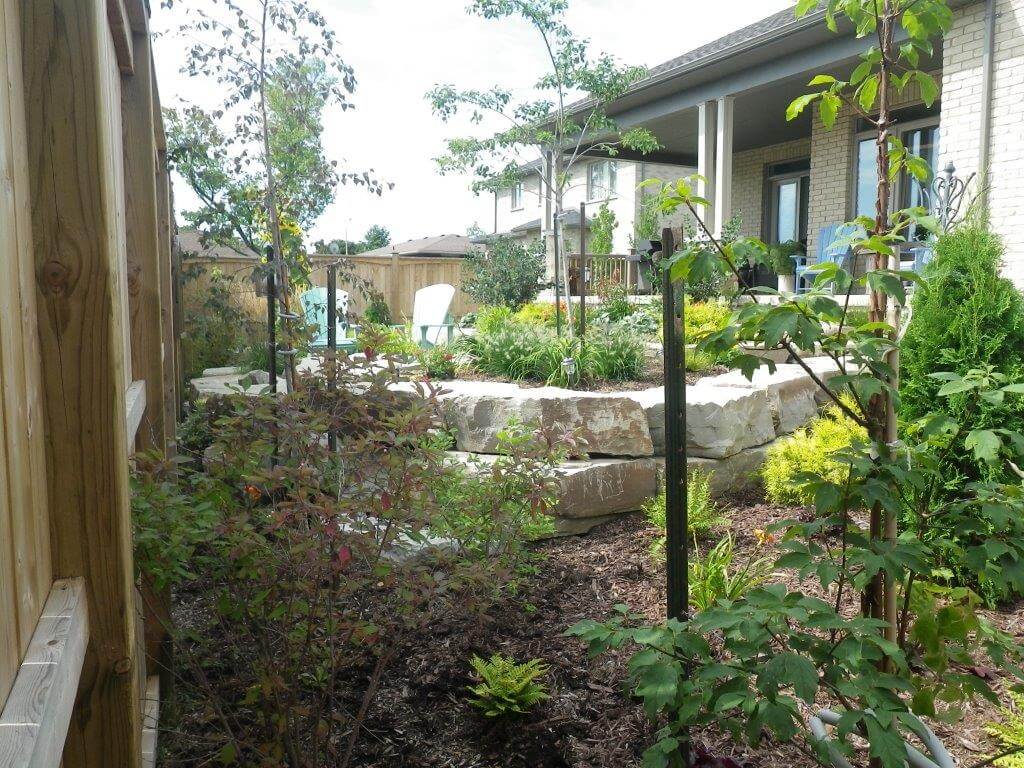
Trees
Large trees may require some maintenance in the form of trimming and/or raking leaves, but they offer many aesthetic and environmental benefits.
If you plan to add trees, give them a wide skirt of exposed earth (out to the drip line) and mulch well. This not only looks good, but furthers the reduction of grass that would otherwise need to be maintained.
Plant Selection
We’re fortunate to have myriad options when it comes to plants, flowers, and shrubs. However, if your goal is low-maintenance landscaping, you’ll want to be selective.
First and foremost, you can ensure the lowest maintenance gardens by choosing plants that are native to your region. These plants thrive in your region’s climate and soils, and historically have grown in the wild with no one but Mother Nature maintaining them. So you can bet they’ll thrive in your garden without too much attention.
Favour perennials over annuals. While the latter tend to be showier, they require more maintenance (deadheading and watering) and need to be replaced every year, adding both time and expense to your gardening requirements. To add pops of colour to your porch and patio but keep maintenance manageable, plant annuals in large containers.
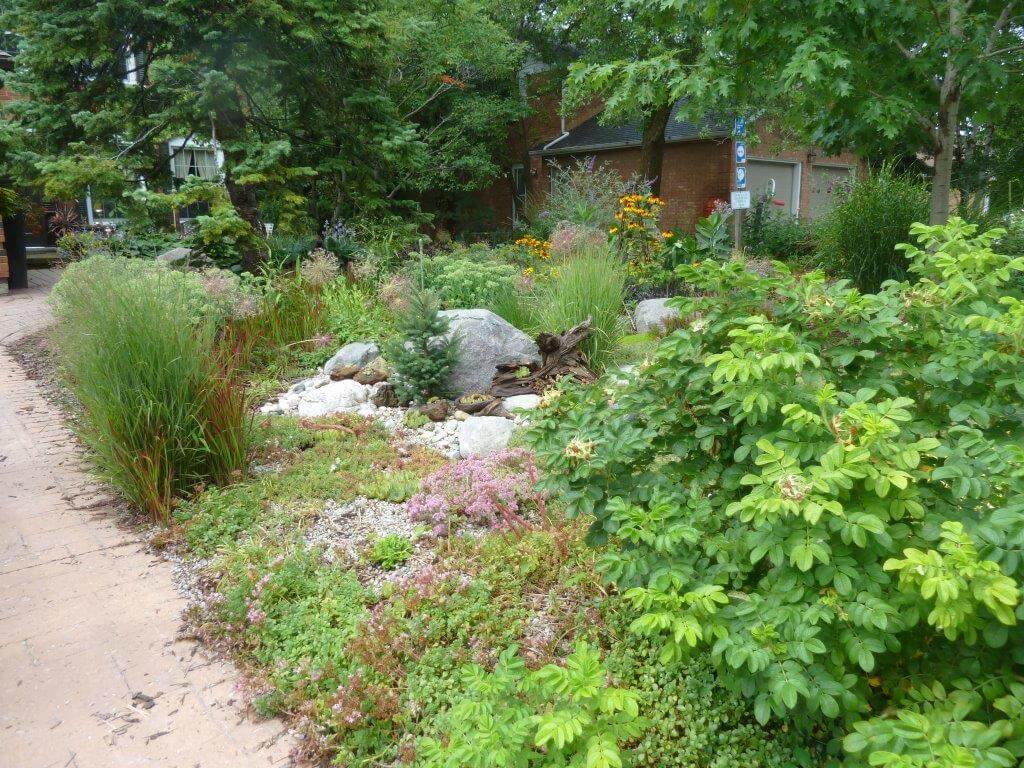
It’s important to consider sun exposure when selecting plants – both annuals and perennials – for gardens and planters. Shade-loving plants will become scorched in anything other than morning sunlight. Sun-lovers planted in the shade will not reach their full potential and will get “leggy” reaching for the sun.
While it’s visually appealing to choose a variety of shapes, sizes, and textures, be sure to select plants for your garden that have similar needs. This will help you avoid having to care for plants individually, permitting you instead to apply what maintenance is required to all plants in your garden.
Beautiful plants come from healthy soil. Soils that are rich in nutrients with good drainage and low competition from weeds will foster healthy plants without much assistance.
Good quality compost adds a wide range of nutrients and healthy bacteria to soil, and can also ensure appropriate drainage. Peat moss can also improve drainage but has an acidic pH. Raised beds also drain better than those dug down into the ground. Finally, a thick layer of mulch will help reduce watering requirements and minimize weed growth. Topped up every spring, mulch also feeds the soil and adds a polished look to flower beds and gardens.
Here in Southwestern Ontario, our outdoor living season is short, so maximize enjoyment by minimizing your work. Consider where you spend the bulk of your time and effort outside and determine ways to reduce or eliminate it so you can spend more time basking in our summer weather, while it lasts.

Once again, it’s the time of year we wait for all winter… Spring! While the planting and growing season is more than a month off, you can prepare now by cleaning up and preparing your lawn and gardens.
If appropriate for our hardiness zone here in Stratford and Perth County (zone 5-6), plants, trees, and grass stand up fairly well to a blanket of snow and cold temperatures. However, conditions can fluctuate throughout the season which can stress exposed vegetation. This winter was a particularly icy one, so you may find more damage than normal, now that a lot of the snow has melted.
We’ve been receiving a lot of calls already for those interested in our lawn and garden maintenance services, and we hope to start visiting customers in the very near future. However, if you’re a DIYer, here are some tips for preparing your landscaping for the upcoming season.
LAWN CARE
Doing a bit of lawn cleanup and maintenance in the spring can help ensure a healthier lawn through the summer while minimizing weeds, so it’s definitely worth investing the time and effort.
It’s important to rake your grass. You definitely want to clean up any leaves and debris that has accumulated over the winter. More importantly though, you want to rake deeply to remove thatch. If left intact, thatch blocks air, water, and nutrients from getting down into the soil. Before you rake however, ensure that your ground is relatively dry to prevent damage to the grass’ root system and avoid compacting the soil, which will happen if you walk on it while it’s wet.
Compaction can be an issue as well. If soils are too compacted, air, water and nutrients are not permitted to get where they need to go efficiently. Aeration is the best way to remedy compaction. Be aware though that the soil cores that are pulled out of the ground during aeration can make a mess, so it’s best to keep lawn traffic to a minimum for a few days after it’s done.
If you notice some bare spots in your lawn, you might consider overseeding. However, overseeding is best done in the fall, as crabgrass is much less of a threat after the first frost. So, consider either waiting until fall, or reapplying in the fall.
Finally, you may opt to fertilize your lawn. If you fertilized in the fall, your lawn may still be digesting residual fertilizer. However, if you do proceed with a spring application of fertilizer, we recommend using a balanced fertilizer (20-20-20) which will help green up the lawn. In addition, the rhyzomes fill in the weaker areas and strengthen the root system. Of course, you can go the organic route as well, by simply top dressing your lawn with an even layer of compost.
GARDEN
As with your lawn, the first thing you want to take care of in your garden is the removal of weeds, dead leaves and debris that’s landed there over the course of the winter. Not only does this make gardens and flower beds look better, but it drastically reduces opportunities for mold growth. You can either remove by hand or lightly rake your gardens to eliminate surface debris. More stubborn foreign objects can be removed with a hoe or small trowel.
After a good general cleanup, remove any wrap or covers that you placed on or over your trees and plants for the winter season. If you’re storing the covers, ensure they’re clean and dry before putting them away to avoid mold and rot from setting in while in storage.
Check plants and trees for damage. Treat or prune away damaged parts if possible, or remove the entire plant if it didn’t overwinter well. Some pruning might be necessary in the spring, but ensure you know the appropriate time of year to prune the plants and trees in your yard. Pruning at the wrong time can negatively affect new growth, flowers, and fruit.
Edging around flower beds is an easy way to increase visual appeal. It also helps keep weeds from creeping in. You can also edge your lawn where it meets the driveway and walkways.
Once the risk of frost has passed, turn your soil with a shovel or small tiller to work in any remaining organic matter and to aerate the soil, which tends to get compacted over the winter. Then you can apply additional soil, compost, and/or amendments to adjust the soil’s pH or increase nutrition.
Spring is a good time to divide your perennials, but be sure that you wait until the risk of frost is no longer an issue. Be sure to add soil and nutrients to backfill newly vacant garden areas as well as the areas you’re transplanting to.
Finally, consider adding a layer of mulch to all of your gardens. Not only does it improve the look of your flower beds, it also insulates your soil against extreme heat, helps retain moisture, and keeps weeds at bay.
All of these things can help you ensure a beautiful, healthy lawn and garden for what we hope will be a long, sunny season ahead. As always, if you’re not a DIY gardener or would like to leave yard maintenance to someone else, we invite you to contact us about our services.

When it comes to landscaping planning and design, many people know what they like when they see it, but just don’t know how to transform their garden from its current state to what they envision. There’s a lot to consider – your preferred style, available space, soil type, irrigation, sun exposure, and maintenance expectations.
Gardens take time, energy, and money to establish and maintain, but starting with a plan can help minimize ongoing cost and effort. When customers call A Touch of Dutch Landscaping & Garden Services we create a plan that incorporates all of the aforementioned considerations. But if you’d like to create a plan of your own, here are some tips for creating something that will work for you and your outdoor space.
Landscaping Planning and Design – Understand Your Space
While we recommend you have at least a general idea of the space you’re working with, many find it helpful to draw or map out the space to get an idea of square footage, nearby elements, sun exposure, and more.
If you are making over an existing garden, consider what has and hasn’t worked in the past. Regardless of whether you’re updating or starting from scratch, think about the location of the garden. Is it against a fence or wall, around a porch, deck, or patio, or will it be exposed on all sides? You’ll want to select plants in a range of sizes to add dimension, and whose height and width will be appropriate for the size of the garden without contributing to a too-sparse or overcrowded appearance.
Understand Your Style
One of the worst times to decide on your style is probably when you’re at a garden centre or nursery. Everything on display is typically in season at that time and so their showy foliage and/or blooms are competing for your attention. Instead, make note of designs that you’re drawn to.
Whether you’re using magazines, Pinterest, or Houzz, or even out and about in your own neighbourhood. Take pictures or jot down notes about general styles and specific elements that you like. This practice really helps inform your plan, so that when you go shopping for plants, you don’t get swayed by some pretty shrub that’s not remotely close to what you’re after.
Understand Your Maintenance Threshold
Maybe you’re a green thumb. But, maybe you’re not. While some amount of maintenance is required for every garden, regardless of style or size, there are ways to minimize the amount of upkeep required to ensure a landscaping project continues to thrive, long term.
If you’re updating an existing flowerbed, consider which individual plants require the most maintenance and get rid of them. When planning for new garden elements, be aware of drought tolerance, sun exposure requirements, standard height and width projections, preferred soil types, and what else is or will be planted in the space. If you make poor plant choices, keeping them alive is going to require more effort than you might be willing to expend. Things like extra watering, fertilization, amending the soil, and trimming might be added to your to-do list on a regular basis.
When you’re putting your plants in the ground, consider adding a layer of mulch or stones. Not only do these extra layers help keep weeds at bay, but they also add a layer of insulation to the soil, keeping warmth in while slowing down evaporation. This means both less weeding and less watering!
Understand Your Limits
If you’re short on time, energy, inspiration, or knowledge, consider leaving the design and installation to a professional landscaper. This will this ensure your project gets done in a timely manner. What’s more, your wishes will be factored into the landscape design to ensure that the end result is beautiful and done right, and meets your design standards.
If you do want to enlist the services of a landscaping company, the sooner you contact the landscaper the better. While we don’t generally start installing softscaping, hardscaping, and water features until May, planning, design, and scheduling gets underway much earlier in the year. So, by the time planting season actually rolls around, we already have much of our season planned. And weather is a big factor, too. Cold weather that persists longer than usual into the spring or that starts earlier than usual in the fall affects our schedule, as does each day of inclement weather during the season.
There’s a saying that if you fail to plan, you plan to fail. That’s probably as true in landscaping as it is in anything else. Having a garden plan can save you time, effort, and money, before during and after you plant. So, investing some time and effort into formulating a plan will pay off. And if you aren’t up for doing your own landscaping planning and design, contact us to discuss how A Touch of Dutch Landscaping & Garden Services can help you design and install the garden you’ve been dreaming of.

In Southwestern Ontario, we’re generally finishing up putting our lawns and gardens to bed for the winter. While some do very little but cut back spent seed heads and dead foliage, others employ measures to cover and protect every tree, shrub, and plant on their property. An approach that falls somewhere in between is generally best to avoid plant and tree loss and ensure a healthy start the following spring. Here are some guidelines to help you ensure you’re adequately protecting your lawn and garden in the winter.
Getting your lawn winter-ready takes very little effort. In fact, you may already be doing most of the items on this short checklist already.
Keep it short
Grass generally stops growing after day time highs remain below 10°C. Your final cut of the season should be between two and two and a half inches. Grass that’s too long may fall over through the winter, encouraging fungal growth. Grass that’s too short leaves it susceptible to stress due to the cold.
Keep it clean
Remove all furniture, toys, and debris (including any notable accumulation of leaves) from your lawn to avoid damage that results in bare patches come springtime.
Minimize traffic during transition
Dormant grass that doesn’t yet have a good layer of snow on it yet can be damaged quite easily when walked on. Try to stay off of grass during this transition.
Keep it insulated
A blanket of snow serves to insulate your lawn during the winter. Once the snow flies and starts to accumulate, keep your lawn blanketed all winter long.
There are a few factors that determine your need to protect plants, trees, and shrubs during the winter:
Exposure to the elements
If a location is exposed to excess wind, snow melt, and/or ice, the vegetation in that area may break or even die before or by the time spring arrives. In addition, if relatively horizontal limbs are suddenly laden with heavy snow or ice, they might bend or even break as a result.
Exposure to road salt
Trees and shrubs that are close to roadways or are in the line of fire when snow is being displaced from roads, driveways, and walkways,
Your plant hardiness zone
Our region (Stratford and surrounding area) is generally classed as hardiness zone 5, so your garden should consist of plants and trees that thrive in this zone. If you’ve tried to push the limit with some of your selections (vegetation that’s appropriate for warmer hardiness zones), you’ll need to take special care to prepare them for winter in Southwestern Ontario.
How well-established the plants in question are
Well-established plants and trees have strong root systems that help sustain them through the cold winter months. On the other hand, those that have been newly planted or moved, particularly after the beginning of September, have not had sufficient opportunity to get established and so will require protection this winter.
If your plants do need to be protected, there are three primary methods used, depending on the plants in questions and what you’re needing protection from.
Wrapping
Wrapping with burlap and twine can protect shrubs from salt spray, drying winds, and/or heavy snow and ice. You might opt to protect younger evergreens and shrubs from frost and heavy snow with a teepee instead, which can be made out of burlap and wood stakes or plywood.
Mulching
A 4 to 6-inch layer of mulch on vulnerable or newly established plants will protect them from the effects of repeated freezing and thawing which can plague our region this time of year.
Mounding
This is simply the act of piling soil up around the base of a plant, and is a great way to protect plants and bushes that are cut back at the end of every season. Mounding is commonly done with rose bushes and hydrangeas, as it protects them from exposure to prolonged cold, ensuring a healthy plant, come spring time.
If you haven’t taken measures to protect your garden yet, an early layer of snow may have you feeling like you’ve missed the boat. However, most vulnerable plants will still benefit greatly from protection, so it’s not too late. Regardless of how long winter is, you can still use the tips above to avoid plant loss and help guarantee a beautiful start to next year’s growing season.